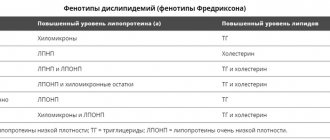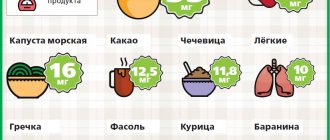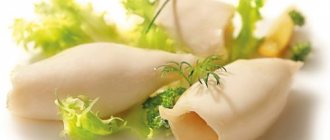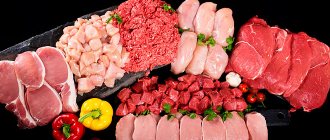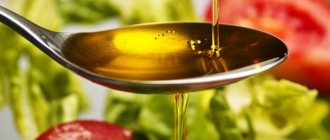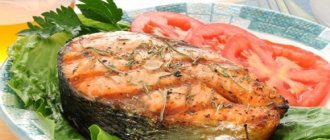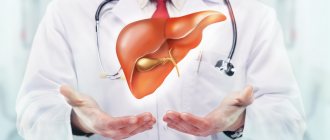Chemical composition of meat products
Depending on the type, cooking method, and fat content, the composition of meat may vary. Being the muscle tissue of animals, it consists largely of water from 50 to 75%. The remaining share is occupied by proteins (about 20%), triglycerides (fats), minerals, and nitrogenous compounds.
The most valuable components:
- vitamin B12;
- animal protein necessary for the regeneration of human muscle tissue;
- iron, calcium, magnesium, potassium.
The cholesterol content in meat is determined by the presence of triglycerides. Any animal carcass contains saturated fats. The exception is fish containing unsaturated (healthy) fat.
Varieties of poultry meat
- chicken;
- goose;
- duck;
- quail;
- turkey;
- partridge;
- grouse.
The presence of fats is influenced by the lifestyle and nutrition of birds. Cholesterol in chicken meat is quite low - 40-80 mg/100g. Chicken breast is considered the most valuable and healthy, and the bulk of triglycerides comes from chicken skin. Therefore, it is recommended to get rid of the skin when cooking. Geese and ducks are waterfowl, so they have a fairly large layer of fat, which affects high cholesterol levels.
Turkey is considered the leader among dietary poultry species. 100 g of turkey contains no more than 60 mg of cholesterol. Turkey protein is 95% digestible. Thanks to the high level of unsaturated fatty acids omega-3 and vitamin K, the heart is stimulated and blood vessels are strengthened.
| Meat | Proteins, g | Fats, g | Cholesterol, mg | Energy value, kcal |
| Chicken | 19 | 13,7 | 40-80 | 220 |
| Gusinoye | 12,2 | 38,1 | 80-110 | 369 |
| Duck | 15,8 | 37 | 70-100 | 365 |
| Quail | 18,2 | 17,3 | 40-50 | 230 |
| Turkey | 19,9 | 19,1 | 40-60 | 250 |
The table shows average values per 100 g of product.
Cholesterol in meat of large and small livestock, offal
Cattle meat includes beef, veal (young beef), small cattle - lamb, goat meat. Beef has low fat content and contains useful compounds such as collagen and elastin, which are involved in the construction of joint tissue. Veal is more tender in taste and is more dietary. Unlike beef, there is virtually no cholesterol in calf meat.
Mutton, lamb, is often recommended for overweight people, as the meat's saturated triglyceride content is extremely low. Thanks to this, lamb can be consumed for vascular atherosclerosis. The exception is lamb tail, which is saturated with fat.
Goat meat is not widely used due to its specific odor. Only young castrated goats are considered a delicacy. In many diets aimed at reducing cholesterol levels, this product is included in the list of allowed foods. There are few fatty streaks, it is easily digestible, and contains almost no contraindications.
Pork is a frequent “guest” in the home kitchen. It is widespread almost all over the world. The composition of pig meat varies significantly depending on the part of the carcass used. The advantage is the ease with which the fatty layer (lard), which is animal triglycerides, can be separated. Pork lard contains a huge amount of bad cholesterol; it is strictly prohibited for consumption by people suffering from atherosclerosis.
Rabbit meat is the most famous dietary type of meat. It is mild in taste, hypoallergenic, and almost completely absorbed by the body. A special feature is the easy separation of fat from the lean part of the carcass. Microelements of rabbit meat have a positive effect on the cardiovascular system and improve blood composition.
Horsemeat contains triglycerides only in the rib region; the rest of the carcass is considered lean. Horse meat is not rich in saturated fatty acids, and therefore cholesterol levels are also low.
| Meat | Proteins, g | Fats, g | Cholesterol, mg | Energy value, kcal |
| Beef | 18,6 | 16 | 80 | 218 |
| Veal | 19,7 | 2 | 70 | 97 |
| Fatty lamb | 15,6 | 16,3 | 200 | 209 |
| Lean lamb | 19,8 | 9,6 | 70 | 166 |
| Lamb | 17,2 | 14,1 | 70 | 196 |
| Goat meat | 18 | 16 | 80 | 216 |
| Pork is fatty | 11,7 | 49,3 | 300 | 491 |
| Lean pork | 17 | 6,3 | 85 | 141 |
| Rabbit meat | 21,1 | 11 | 50 | 183 |
| horsemeat | 20,3 | 7,3 | 68 | 140 |
As can be seen from the table, rabbit meat contains the least amount of cholesterol, while fatty pork contains the most cholesterol.
Cooking has its own peculiarities. The first broth contains a lot of fat, so it is better to drain it. Boiled meat contains less sterol than fried meat.
It is not recommended to consume by-products if you have hypercholesterolemia. The brain, liver and heart are capable of accumulating it. Sausages should be consumed with caution; they often contain lard and offal.
Beef and lamb
One hundred grams of beef contains about 18.5 g of protein, a large amount of zinc, magnesium, vitamins and choline. By consuming such meat, the body is enriched with nutrients, and hydrochloric acid and enzymes are neutralized by gastric juice. This reduces the level of acidity in the stomach.
Tender meat fibers and a small amount of subcutaneous fat contain unsaturated acids, so beef is considered a dietary product. But moderation should be observed; overeating causes an increase in cholesterol.
You need to buy beef from trusted places, as it must be raised on high-quality feed. If a cow is injected with hormonal drugs and antibiotics that stimulate growth, the meat will not contain anything useful.
The undoubted advantage of lamb is its large amount of protein, and it also contains less fat than beef. Lamb contains the valuable substance lecithin, which normalizes cholesterol metabolism, thereby reducing the likelihood of developing vascular atherosclerosis.
About half of lamb fat consists of:
- polyunsaturated omega acids;
- monounsaturated fats.
Meat is often recommended for dietary nutrition for patients with anemia.
Fatty pieces of lamb have a high calorie content and contain saturated fats, which cause jumps in low-density cholesterol. One hundred grams of lamb contains 73 mg of cholesterol and as much as 16 g of fat.
Frequent and abundant consumption of such meat contributes to the development of atherosclerosis and blockage of blood vessels. There are substances in bones that trigger arthritis.
How to choose the right meat?
In order for eating meat to bring benefits, and not vice versa - to harm the body, you need to comply with certain criteria when purchasing meat:
- The meat should be a bright color. A dull color indicates that the meat is of poor quality and not fresh.
- When pressed, a notch forms in fresh meat and quickly disappears; in spoiled meat, the notch does not disappear and liquid accumulates in it.
- Fresh meat when cut has a thin crust of a pink-red color (pork), a whitish-pink tint (veal), or a brown-red tint (lamb).
- During a visual inspection, you need to pay attention to the presence of helminth eggs; they look like millet and can crunch when cutting meat.
- Unhealthy shine and stickiness also indicate spoiled meat.
- If the cut meat has a greenish or bluish tint, you should not buy such meat.
Pork
Lean pork is considered the most healthy and easily digestible; it contains no more fat than lamb and beef. It contains vitamins B, PP, magnesium, zinc, potassium and iodine. The amount of cholesterol depends on the age of the animal and its fatness.
The meat of a young pig is equal to the properties of turkey or chicken, since it contains little fat. If the animal was fed intensively, the meat contains many times more fatty tissue. The fattiest will be goulash, neck, and hip.
There are also serious disadvantages: pork provokes severe allergic reactions and contains a lot of histamine. Eating lean pork is also undesirable for diabetics who suffer from pathological conditions:
- gastritis;
- hepatitis;
- high stomach acidity.
Reasonable consumption of pork will help reduce cholesterol levels in diabetics, reducing the likelihood of developing cardiovascular diseases. It is noteworthy that lard contains an order of magnitude less cholesterol than butter and chicken yolk.
One hundred grams of lean pork contains 70 mg of cholesterol, 27.1 mg of fat, and lard contains no more than 100 mg of a fat-like substance.
Poultry (chicken, turkey, game)
There is little cholesterol in poultry meat; the undoubted leader is skinless fillet. Patients with high cholesterol levels are first recommended to eat chicken. It will be an excellent source of animal protein, amino acids and B vitamins. The fat in poultry is usually unsaturated, that is, it does not increase cholesterol levels in a diabetic.
Dark meat contains a lot of phosphorus, and there is many times more potassium, iron and zinc than white meat. For this reason, boiled chicken is included in many dietary dishes and in healthy nutrition menus.
Chicken meat has a positive effect on the nervous system and is recommended for prevention:
- atherosclerosis of blood vessels;
- diseases of the cardiovascular system;
- obesity.
It must be remembered that different parts of the carcass contain different amounts of fat. Saturated fat is located under the skin, so it is advisable to remove it to release the dietary product. There is less fat in the top part of the chicken, most of all in the legs.
Turkey is a great alternative to chicken. It also contains high-quality protein, a complex of vitamins, essential amino acids, microelements, and macroelements. At the same time, the product has a low calorie content.
Turkey contains the same amount of phosphorus as fish and crabs, but is more easily absorbed by the body. Dietary properties make it possible to use such meat in the diet of patients with diabetes mellitus and vascular atherosclerosis.
Doctors advise giving turkey to children even if there is anemia due to diabetes. The cholesterol level in the product is 40 mg for every 100 grams. Despite its valuable qualities, there are also disadvantages - it has thick skin with fat. Therefore, it is necessary to get rid of it.
You should also not eat offal:
They contain too much cholesterol. But the tongue, on the contrary, is considered a delicacy, it has few calories and no connective tissue. Such characteristics make it an ideal dietary product that does not burden the digestive tract.
Game is also considered a dietary product. The meat of poultry, elk, roe deer and other animals contains little fat and a maximum of valuable substances. Game is prepared just like regular meat; it can be stewed, baked or boiled. It is useful to consume nutria, rabbit, horse meat, and lamb meat in moderation.
Below is a table that will show which meat has more cholesterol.
| Type of meat | Protein (g) | Fat (g) | Cholesterol (mg) | Calorie content (kcal) |
| Beef | 18,5 | 16,0 | 80 | 218 |
| Mutton | 17,0 | 16,3 | 73 | 203 |
| Pork | 19,0 | 27,0 | 70 | 316 |
| Chicken | 21,1 | 8,2 | 40 | 162 |
| Turkey | 21,7 | 5,0 | 40 | 194 |
What are the benefits of meat?
You can often hear heated discussions about whether you should eat meat or not. Among the majority of opinions, two are in the lead: first, you need to eat, second, there is nothing good from eating it.
Since the article is devoted to a different topic, we will not take either side, but will only indicate how this product is useful:
- Meat is a valuable source of protein, which is the dominant organic compound in the body, consisting of nonessential and essential amino acids. The latter come exclusively from food since they are not synthesized in our body. Thus, by eating meat products, we replenish the protein reserves of which we are composed. Therefore, it is important to eat animal products for children, athletes, pregnant and lactating women, people who have suffered fractures or other serious somatic diseases;
- Meat contains a fairly high set of micro- and macroelements necessary for the body:
- iron is needed for hematopoiesis and increasing hemoglobin levels;
- calcium is needed for bone and dental tissue;
- potassium is involved in intercellular transport processes;
- zinc takes part in providing protective systems;
- manganese and magnesium stimulate the faster occurrence of many biochemical reactions;
- vitamins A, B and D stimulate the immune system, renewal of epithelial tissues, improve vision, nervous activity, and hematopoiesis.
To eat or not?
There are heated debates every day about the benefits and harms of meat. While some consider it an indispensable product, others are sure that it is difficult for the body to digest meat and it is better to give it up.
The benefits of meat are determined by its composition; it contains a lot of protein, microelements, macroelements and vitamins. Opponents of meat talk about the inevitable development of heart disease just because of consumption of the product. But at the same time, such patients still suffer from vascular atherosclerosis. Therefore, reasonable consumption of meat does not entail problems with fat-like substances.
For example, lamb contains an important substance called lecithin, which regulates cholesterol levels. By eating chicken and turkey, a diabetic's body will be saturated with vitamins and minerals. Meat protein fully improves the functioning of the central nervous system, starts metabolic processes, and normalizes cholesterol metabolism.
What types of meat are most useful are described in the video in this article.
Benefits of eating meat
Meat dishes are part of the daily nutritious diet of most people, are combined with various foods and have the following beneficial qualities:
- Meat contains all the amino acids necessary for the body, which are absent in proteins of plant origin, are not produced by the liver and are important for the biosynthesis of its own proteins. Proteins form the basis of cells, are a storehouse of energy, play the role of neurotransmitters (participate in the transmission of nerve impulses), and regulate the function of vitamins and minerals.
- Meat is a donor of L-carnitine and coenzyme Q 10, substances necessary for the normal functioning of the heart muscle.
- Meat contains vitamins B6 and B12, which are essential for the functioning of the central and peripheral nervous system, hematopoietic organs and which are donors of methyl groups (antioxidants responsible for the body’s response to stress, involved in tissue detoxification and having an anti-inflammatory effect).
- Creatine contained in meat is needed for energy metabolism in muscle and nerve cells. Also, creatine slows down the accumulation of lipofuscin pigment - a marker of aging and wear and tear of the body, has a positive effect on mental abilities and inhibits the progression of Parkinson's disease.
- Heme iron (found in “dark” meat) is very well absorbed by the body and is necessary for people suffering from anemia.
- Meat includes multiple trace elements: potassium, calcium, zinc, magnesium, manganese.
What are the benefits of eating meat?
Harm
Vegetarianism is becoming popular at the moment.
This direction completely excludes the consumption of meat, not only for ethical and religious reasons, but also based on the medical disadvantages of consuming this product:
- Meat products contain a high concentration of cholesterol , which is directly proportional to the part and type of meat and culinary processing.
- Meat is difficult to process and lingers in the gastrointestinal tract for a long time due to lack of fiber. That is why, after eating meat dishes, there is heaviness and discomfort in the abdominal area.
- Meat from animals raised under conditions of accelerated growth contains thyroid and sex hormones, which will disrupt the human hormonal balance and negatively affect health.
- Eating meat products is contraindicated for gout due to their high protein content.
Foods containing cholesterol
Cholesterol is a fat-like substance and belongs to the group of sterols of animal origin. Accordingly, plant foods do not contain cholesterol. Most of this substance is synthesized in the body by the liver, and only about 20% comes from the food consumed.
However, to prevent an increase in the level of low-density cholesterol, which is the cause of the development of pathology, it is recommended to adhere to proper nutrition. In this regard, it is necessary to know which foods contain the most cholesterol. Products with a high content of low-density lipoproteins must be excluded from the diet of patients suffering from vascular atherosclerosis.
Cholesterol and health
Cholesterol is an essential component of our body. It is more correctly called cholesterol (chemical name), which is a substance from the family of lipophilic alcohols. The vast majority of it is synthesized in liver cells and only about 20% enters our body with food.
It is a very important component of all tissues; therefore, when the amount fluctuates in the body, pathological processes begin to occur, for example, with a decrease, there is a risk of developing oncological processes, and with an excess, the formation of fatty plaques in the arteries and veins is provoked.
The body needs cholesterol because:
- is an obligatory component of the cytoplasmic membranes of all mammals;
- Without it, the synthesis of steroid hormones, bile acids and vitamin D will be impossible.
The normal concentration in the blood is from 3.4 to 5.2 mmol per liter, which is necessary for the full functioning of the body. According to data released by scientists belonging to the American Heart Association, in order not to develop negative processes in the bloodstream, daily cholesterol intake should not exceed 300 mg.
How does diet affect lipid profile?
The daily human diet contains foods that increase cholesterol levels in the blood. It is common to distinguish between bad (LDL) and good (HDL) cholesterol. In the second case, lipoproteins have a positive effect on the body and do not cause disease. Foods that may contain “bad” cholesterol primarily include meat, dairy products and eggs.
They are saturated with animal fats, which produce low-density lipids. At the same time, vegetable fats do not affect the level of lipoproteins, since they have a different chemical structure and contain sitosterol and polyunsaturated fatty acids. They, in turn, on the contrary, normalize fat metabolism.
Thus, the indication on the label of vegetable oil that it is cholesterol-free does not correspond to reality - it cannot be there. The largest amount of LDL is found in refractory meat fat. In addition, the risk of developing atherosclerosis when consuming certain foods is assessed depending on what type of fatty cholesterol acids predominates in them. These can be harmful saturated ones or anti-atherogenic unsaturated ones.
Thus, beef fat contains a large amount of solid unsaturated fats and is a product contraindicated in atherosclerosis. Eating beef every day can significantly increase blood cholesterol levels. At the same time, the increased content of lipoproteins in sea fish does not prohibit their consumption, since it is high in density and normalizes lipid metabolism in the body due to the content of polyunsaturated fatty acids.
Experts divide all products that contain low-density lipoproteins into 3 groups: those that need to be excluded from the diet (“red” list), those that do not significantly increase cholesterol (“yellow” list) and those that have a positive effect on fat metabolism in the body (“green” list). " list).
The list of foods containing cholesterol and information about its amount (mg) is presented in the table:
| Meat | Bird | Fish | Dairy |
| Beef (pulp) – 80 | Chickens – 80 | Krill – 1250 | Russian cheese – 1130 |
| Pork (pulp) – 70 | Goose – 110 | Horse mackerel – 400 | Dutch cheese – 510 |
| Lamb (pulp) –70 | Duck – 50 | Mackerel – 280 | Butter – 180 |
| Rabbit – 40 | Turkey – 210 | Carp – 270 | Sour cream 30% – 130 |
| Beef fat – 110 | Flounder – 240 | Mayonnaise – 100 | |
| Lamb and pork fat – 100 | Herring – 200 | Homemade cottage cheese – 60 | |
| Beef by-products – 150-3000 | Hake – 140 | Cream 20% – 80 | |
| Pork offal – 50-2000 | Pollock – 110 | Cow's milk – 10 | |
| Cod – 30 | Condensed milk - 30 |
For people with elevated LDL levels and those suffering from atherosclerosis, it is necessary to consume foods with the least amount of bad cholesterol. Dairy and curd products must be low-fat.
Some foods can reduce the content of unnecessary lipoproteins and remove them from the body. These include: fresh vegetables and fruits, juices from them, fish with a high concentration of polyunsaturated fatty acids, vegetable oils.
Which meat has more cholesterol?
It is important for meat lovers to know how much cholesterol it contains and which meat contains the most low-density lipoproteins. The chemical composition of meat is as follows: protein - up to 22%, water - up to 72%, unsaturated fats - up to 48%.
It is unsaturated fats that affect blood cholesterol levels. But meat varies in the content of high-density or low-density cholesterol, so you need to determine which meat has a higher concentration. Thus, the most bad cholesterol is found in fatty beef and pork. While rabbit and chicken are considered dietary meat, they contain the least amount of lipoproteins.
There is cholesterol in beef, or more precisely, in the pulp, but there is not much of it. Low-density lipoproteins are found in large quantities in beef fat and offal. It is believed that the richest product in lipoproteins is beef brains.
The content of unhealthy fats in beef is as follows:
- beef brains – 3100 mg;
- beef liver – 400 mg;
- beef tongue – 87 mg;
- pulp – 80 mg.
People with high levels of LDL in the blood and diagnosed atherosclerosis can only eat boiled or stewed beef or steamed cutlets. It is strictly forbidden to serve them meat fried in oil. Unlike beef, pork is fattier. Nevertheless, due to the fact that it contains less refractory fat, the digestibility of pork is slightly better.
It is recommended to choose leaner meat, and excess fat should be trimmed before cooking. Pork dishes are best stewed, baked or boiled. Fried pork will not benefit the body. Meat that is cooked in hot oil contains an excessive amount of harmful substances.
Although pork is not one of the leading products in terms of low-density lipoprotein content, nevertheless, such an organic compound is present in it in significant quantities:
- pork brains – 2000 mg;
- pork kidneys – 300 mg;
- pork liver – 130 mg;
- pulp – 80 mg;
- pork tongue – 50 mg.
Compared to beef and pork, lamb contains 2.5 times less LDL. 100 g of this product contains 97 mg of cholesterol. The same amount of lamb contains 9 g of unprotected fatty acids. This meat should also be consumed in moderation, avoiding frying. Among the types of cattle meat, horse meat contains the least cholesterol - 68 mg per 100 g.
As for rabbit, its meat is considered one of the most dietary products of animal origin with low cholesterol content. Per 100 g of this product there are 123 mg of low-density lipoproteins. But this is not “bad” cholesterol. The least amount of lipoproteins is found in chicken meat, the fats of which are unsaturated and therefore do not increase the risk of developing atherosclerosis. This is why white chicken meat can be eaten if you have high cholesterol.
Chicken skin contains the most bad cholesterol, so it must be removed before cooking. LDL levels can be affected by chicken by-products, so patients with atherosclerosis should limit or eliminate their consumption. Chicken meat contains lipoproteins in the following quantities:
- skinless fillet – 35 mg;
- red meat – 89 mg;
- chicken heart – 170 mg;
- chicken liver – 492 mg.
Offal and sausages are especially harmful. They should be completely excluded from the diet.
The effect of cholesterol on the body
Cholesterol is the main element of fat metabolism, the synthesis of which occurs to a greater extent in the liver (about 80%) and partially comes with food (20%).
A sufficient amount of cholesterol is necessary for the production of bile acids, proper metabolism, the synthesis of vitamin D and steroid hormones (minerals and glucocorticoids).
Cholesterol is the content of the myelin sheath of nerves and contributes to the proper transmission of nerve impulses. Cholesterol is also part of the structure of cellular structures and is responsible for their elasticity and permeability.
An increase in cholesterol concentration leads to the development of atherosclerotic vascular damage and the formation of the following diseases:
- Coronary heart disease and hypertension (threat of acute myocardial infarction).
- Ischemia of cerebral vessels (threat of hemorrhagic/ischemic stroke).
- Ischemia of the kidneys and intestines (possible thrombosis of intestinal vessels, development of chronic renal failure).
- Vascular ischemia of the lower extremities (risk of developing trophic ulcers, gangrene of the legs).
The recommended daily requirement for cholesterol is about 250 - 300 mg, necessary for the general functioning of the body, regardless of the person’s age and gender.
Where is the most cholesterol?
Other high content foods
The cholesterol content in foods varies and depends on their fat content. The list of foods containing “bad” cholesterol is complemented by butter. Natural butter is made from cow's milk by churning. This product is concentrated milk fat, the content of which varies from 78 to 99%. The highest concentration is observed in ghee.
Since dairy cream is an animal product, butter contains cholesterol. Excessive consumption of butter can lead to an increase in the level of fatty lipids in the body. Its moderate distribution in the diet will not cause harm, since this product contains beneficial fat-soluble vitamins necessary for the normal functioning of the body.
If you eat butter with every meal and supplement it with baked goods with cream, then cholesterol will inevitably increase. A study of the composition of this product indicates that it contains less LDL than meat. There are 280 mg of LDL per 100 g of ghee. 100 g of butter with a fat content of 78% contains 240 mg of lipoproteins.
Nutritionists warn patients with atherosclerosis against excessive consumption of chicken eggs, or rather, their yolk, justifying this by its high cholesterol content - up to 280 mg. Therefore, people with high cholesterol levels are advised to limit this product to 1 piece per week. At the same time, the ban does not apply to egg whites.
Scientists have identified a relationship between coffee consumption and increased blood cholesterol levels. At first glance, such a connection is very doubtful. In fact, coffee contains a substance called cafestol, which can affect your cholesterol levels. This is due to the fact that cafestol accelerates the process of lipoprotein formation.
The amount of this substance in the drink may vary depending on how the coffee is prepared. Thus, espresso coffee contains the most cafestol, so it is not recommended to abuse it. Meanwhile, instant coffee, which is used in most cases, does not affect cholesterol levels. But excessive consumption of instant coffee also has a negative impact on well-being.
There is one way by which you can reduce the cafestol content in natural coffee. Since the substance that promotes the synthesis of cholesterol is contained in the oil of coffee beans released during brewing, it is enough to strain the finished drink through a paper filter. A similar device is found in some coffee machines.
A person’s food influences the likelihood of developing atherosclerosis, so the diet of patients with atherosclerosis must be balanced. Diet is an integral part of the treatment of this disease, and correction of eating habits is necessary.
Foods that help lower bad cholesterol levels include fruits and vegetables and grains. However, you should not completely give up foods containing animal fat. It is necessary to differentiate them by the level of harmful substance content and consume only those products that have a minimal impact on the level of cholesterol in the blood.
What seafood can you eat if you have high cholesterol?
Let's start with the fact that it is not only possible, but also necessary to eat cholesterol-free seafood, namely seaweed. It is included in many diets to lower blood cholesterol levels.
As for other seafood and fish, there are certain recommendations.
- You can eat seafood and fish that contain little fat often and with benefit for your body. These are scallops, crab, mussels, squid, cod, haddock, etc.
- A little less often you can treat yourself to shrimp and oysters.
- On special occasions, but rarely, you can afford a little caviar.
If you have cholesterol, you can eat seafood, but you just need to know in moderation, then you can get all the benefits that seafood provides without harming your body.
